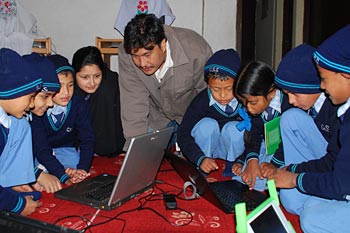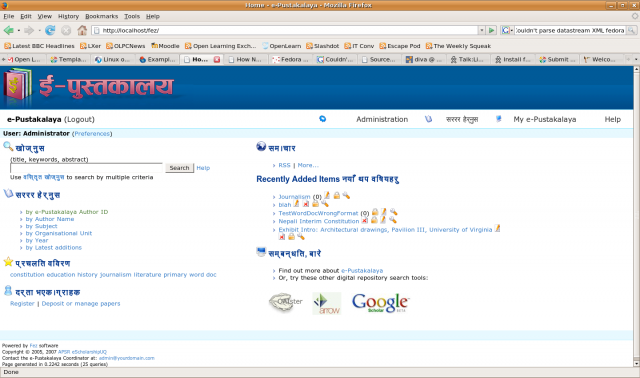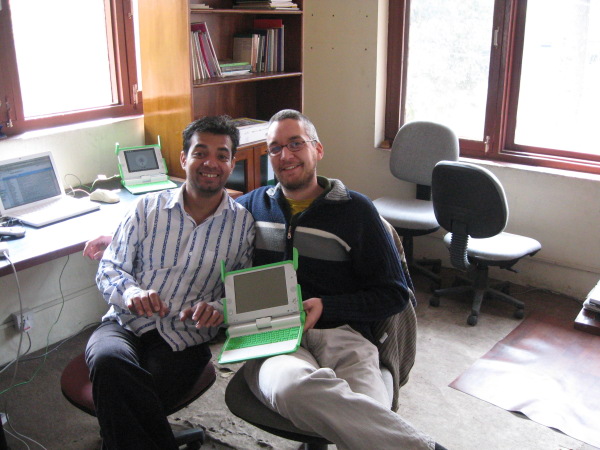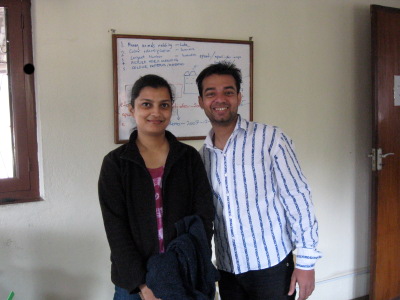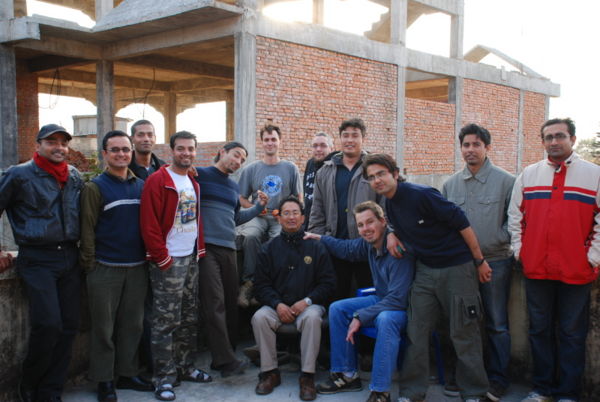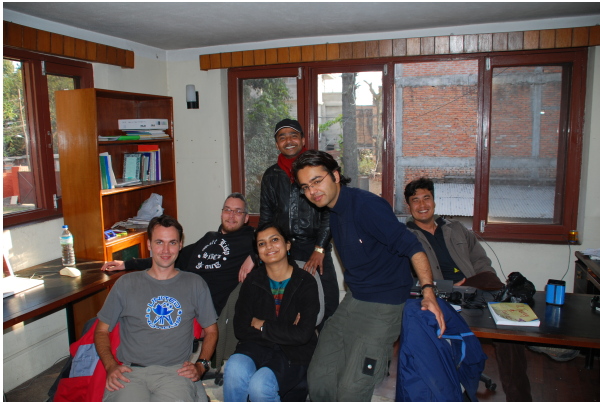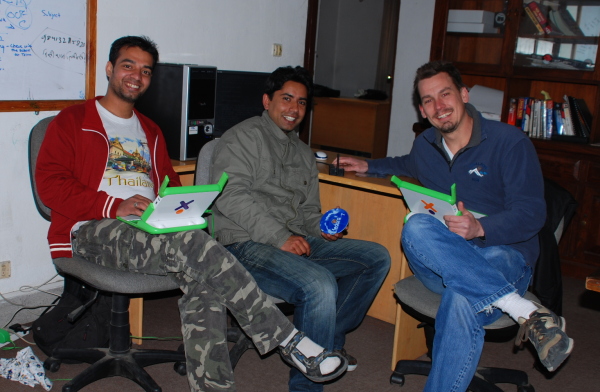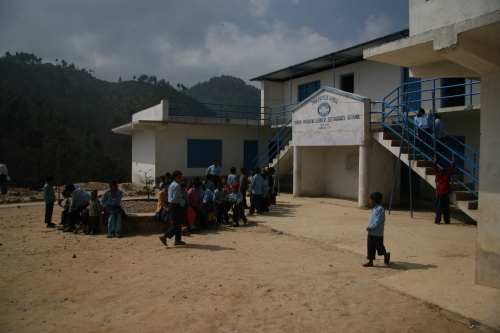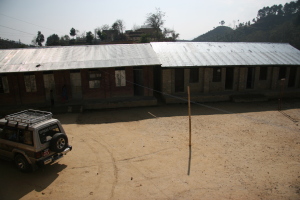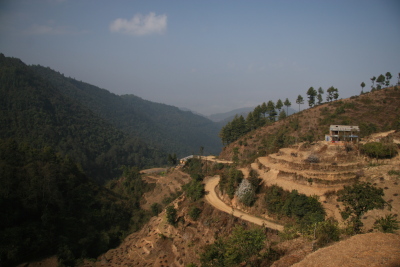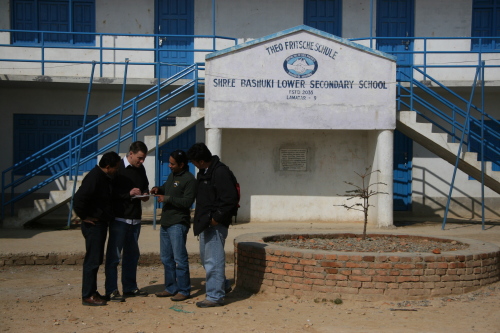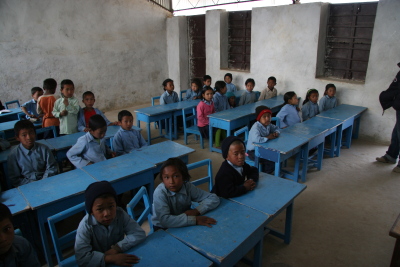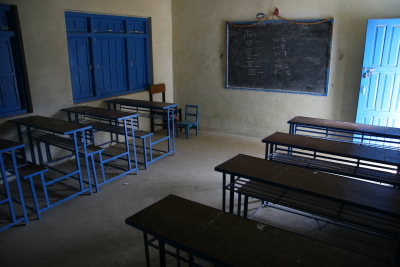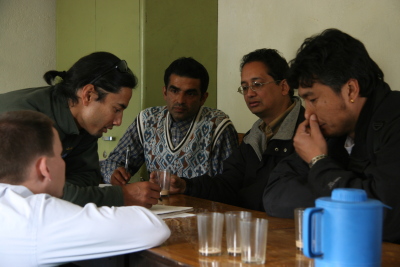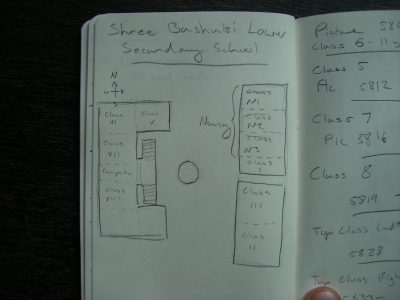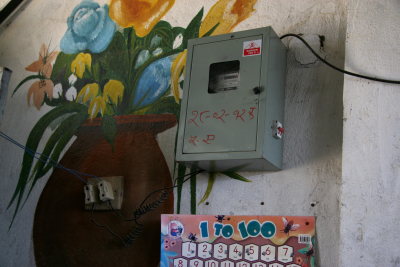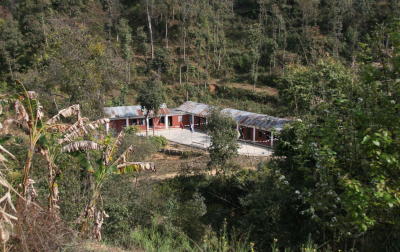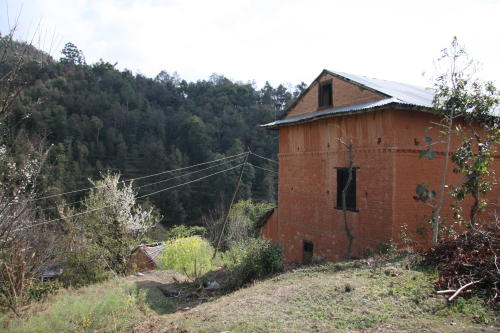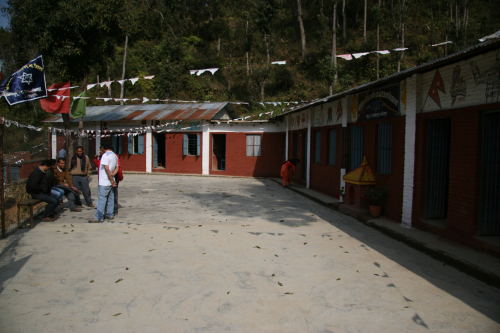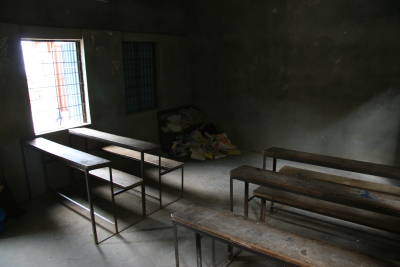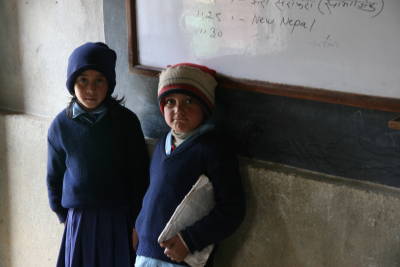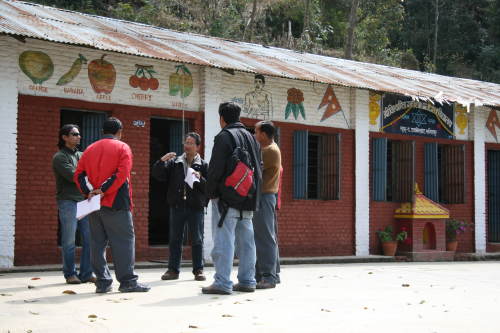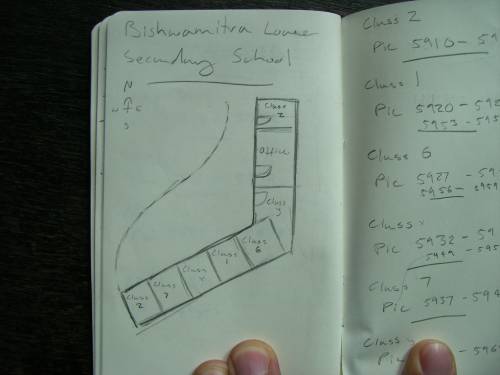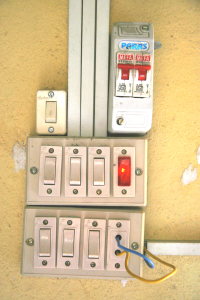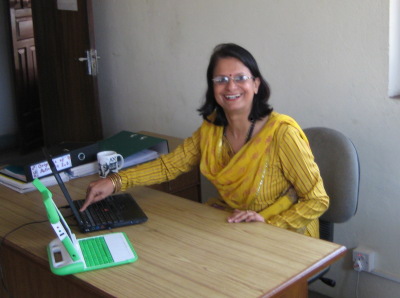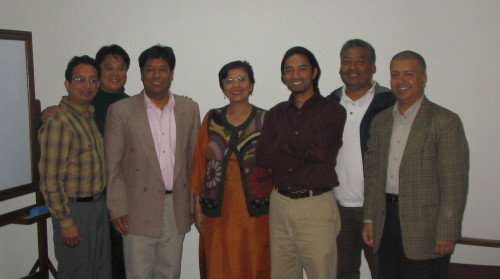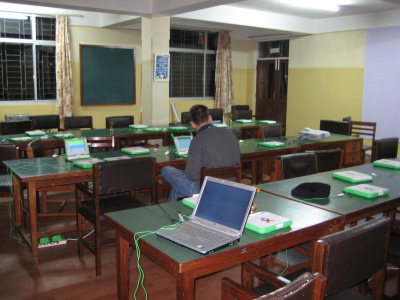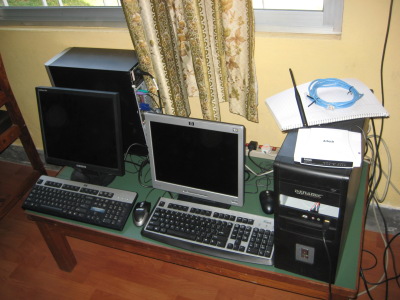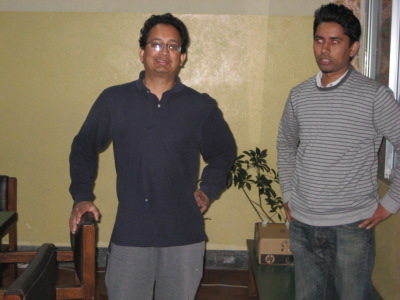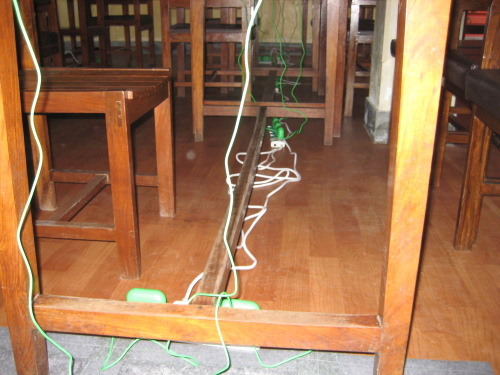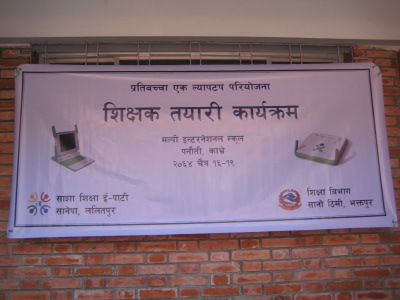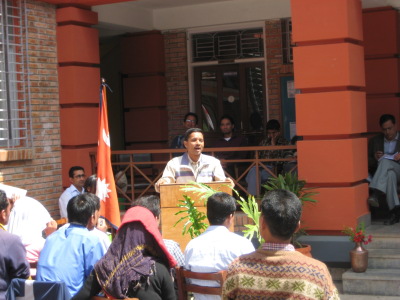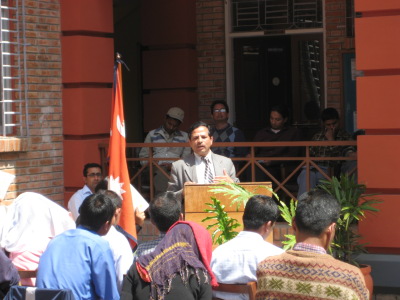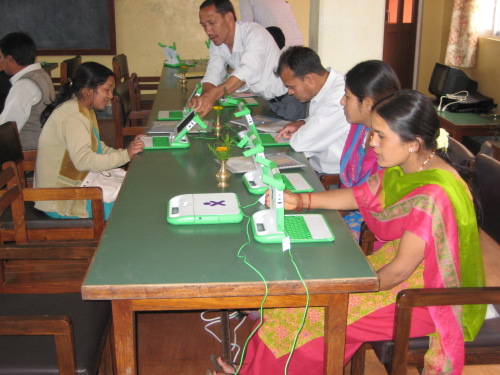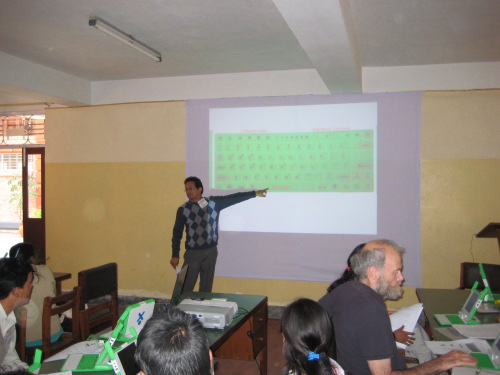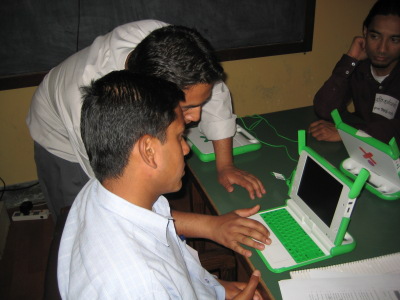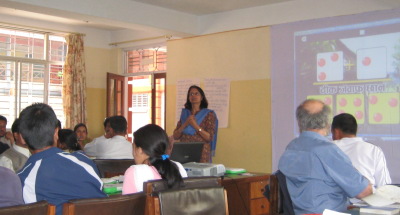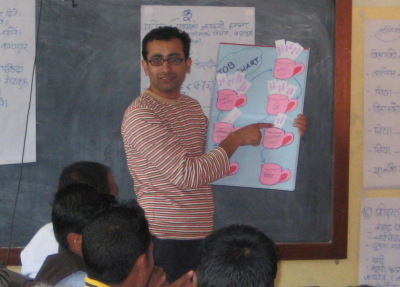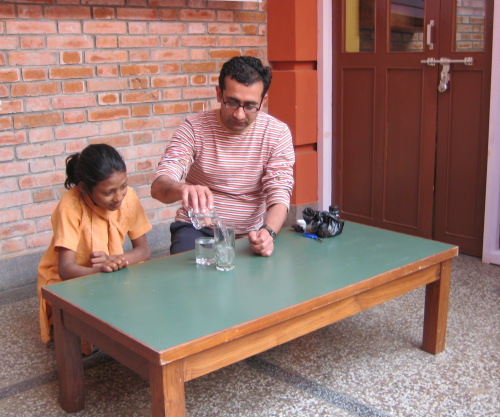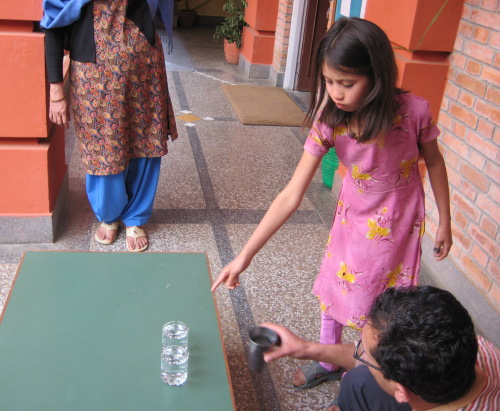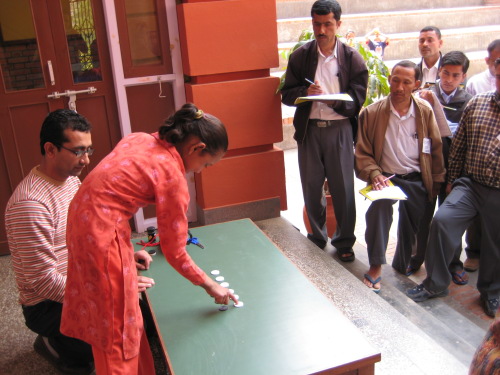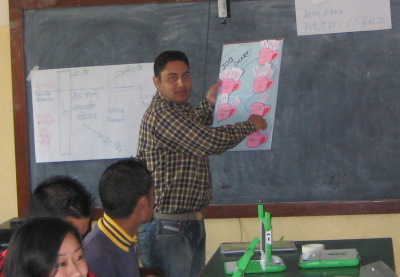OLE Nepal: Blog Uncategorized: Difference between revisions
(New page: <center><div style="background-color:#c1fea1; border:1px solid #cdf; padding:0px; align:center;font-size:120%" class="plainlinks"> '''← Testing''' &n...) |
(migrating content from OLE Blog) |
||
| Line 6: | Line 6: | ||
<br/> |
<br/> |
||
{{TOCright}} |
{{TOCright}} |
||
=Uncategorized= |
|||
==The XO goes to School== |
|||
[http://blog.olenepal.org/index.php/archives/102 The XO goes to School]<br> |
|||
December 6th, 2007 By: admin |
|||
Today we went to ‘GoodShepherd School’ to test the learning activities that we had developed for the XO. This was the first time that we got to test our activites with a group of school students. It was a great learning experience for the chidren and for us too. |
|||
[[Image:Ram_xo.jpg|Ram with XO and children]] |
|||
Apart from the learning activities the children were most interested by the camera on the XO, they were really excited to see themselves on the screen. We feel that it will be more fun and really interesting for the kids when we have more XOs and we can develop learning activities that use the camera and the mesh features. |
|||
Thanks to Squeak our software ran without a hitch on each of the four laptops that we had available (Linux, Mac, Windows, OLPC-XO) and it was quick and easy to install on the school’s own computers too. |
|||
Special thanks to Bert, Yoshiki, Karl, and the whole OLPC Etoys mailing list for their friendly expert advice! |
|||
==Working On the Library== |
|||
[http://blog.olenepal.org/index.php/archives/104 Working On the Library]<br> |
|||
December 13th, 2007 By: admin |
|||
[[Image:E-pustakalaya-frontpage.png]] |
|||
I have put a lot of work these two weeks into building a prototype library for Nepal’s pilot of OLPC. It is my understanding from an e-mail conversation with S.J. that OLPC hasn’t decided on a system for the library. For the time being I am much more concerned about the back-end of the library than the user interface. I don’t think that it will be incredibly hard to design a simple user interface for kids to search a repository. The harder part is to find a powerful back-end that will be able to accommodate our needs as they grow over time. |
|||
After some cursory research, there appear to be three leading open-source repository systems |
|||
[http://www.eprints.org/ Eprints] |
|||
[http://www.dspace.org/ Dspace] — used in OpenCourseWare, and |
|||
[http://www.fedora-commons.org/ fedora] — not to be confused with Fedora Linux |
|||
Being the incredibly lazy person that I am, I did not go to the trouble of installing and testing each one of these repositories. Instead I spent half a day reading reviews, blog posts, and news group discussions comparing various repository packages. After reading this [http://blog.olenepal.org/home/sites/default/files/Repository%20Evaluation%20Document.pdf evaluation of the leading three repository systems] and watching this [http://www.fedora-commons.org/about/outreach.php#video video], I decided to try out fedora. |
|||
After many painful hours I got fedora set up. Actually, it is quite easy to set up fedora, which is a pure web service. I found installing the most popular UI Fez rather difficult to get set up. I see this decoupling of service and UI as a strong positive in fedora’s favor. We need a very simple kid-friendly UI for kids, a more advanced one for teachers, and a very advanced one for the people who will load materials into the library. |
|||
I would love to hear from someone who actually knows about repository systems and can explain to me the benefits of one system over another. I will be in the US for 5 weeks starting Dec 16th and one of my goals will be to really understand online libraries so I can build an awesome one for Nepal. |
|||
I have put a rough install guide on [http://wiki.laptop.org/go/Install_fedora_library_server how to set up fedora] with the Fez UI on Ubuntu. There are already install guides for fedora and Fez but I encountered several problems during the install. |
|||
So, I would love to hear from people who actually know about these kinds of systems. |
|||
By the way, e-Pustakalaya means “e-Library” in Nepali. The title in the upper-left of the screenshot reads the same in Devnagari script. |
|||
==We welcome Two New Volunteers to Nepal== |
|||
[http://blog.olenepal.org/index.php/archives/139 We welcome Tow New Volunteers to Nepal]<br> |
|||
February 18th, 2008 By: bryan |
|||
We are very excited to have two new volunteers working with us to |
|||
advance the OLPC project in Nepal. They come from very different |
|||
backgrounds but with the common goal to improve education for the |
|||
world’s poorest, and umm, of course they are also excited to work with |
|||
super cool technology. |
|||
[[Image:Dev-n-ties_small.jpg]] |
|||
Dev Mohanty (left) and Ties Stuij (right) |
|||
Ties Stuij comes to us from Rotterdam in the Netherlands. He is a |
|||
long-time Common Lisp hacker who knew Luke Gorrie from Lisp |
|||
conferences. He also has a background in journalism and hopes to do a |
|||
good bit of writing about the OLPC project in Nepal. You can read |
|||
about his work with Common Lisp open-source projects at his personal |
|||
website [http://fallenfrukt.com]. Ties will be working very closely with |
|||
our Development team to build exciting learning activities. He expects |
|||
to stay in Nepal for approximately five months. |
|||
While the technical aspects of this project fascinate Ties, he is |
|||
motivated by a larger social concern. “I have always been concerned |
|||
with the problem of inequality. OLPC has an exciting opportunity to |
|||
address the problem of inequality in education and I am here in Nepal |
|||
to contribute as best I can.” |
|||
[[Image:Dev-n-manisha_small.jpg]] |
|||
Dev and his lovely lady friend Manisha |
|||
Dev Mohanty is originally from Bangalore but has lived for many years in France, Singapore, and Bangkok. He has an extensive background in |
|||
mobile communications, primarily with Ericsson Corporation. He is |
|||
particularly interested in using WiMax technologies to connect rural |
|||
communities to the Internet. Recently he participated in the WiMax |
|||
installation in Cambodia. |
|||
Our Director of Networking, [http://olenepal.org/executive.html#management Mahabir Pun], has been dragging Dev around |
|||
rural Nepal for the last several months, connecting rural villages to |
|||
the Internet as part of the [http://www.nepalwireless.net/ Nepal Wireless Project]. For the next several months, Dev will be working with |
|||
myself and Sulochan on connecting the pilot school to the Internet, |
|||
hardening the mesh network, and improving the School Server. Due to |
|||
his experiences connecting rural Nepali villages to the Internet, Dev has |
|||
seen first hand how Internet access can improve the quality of life |
|||
for rurall communities. “I am excited about working on this project in |
|||
Nepal and I hope that the work I do here will help similar efforts in India.” |
|||
We are always looking for talented contributors to come work with |
|||
us in Nepal, but you don’t have to come to Nepal to make a big impact on the OLPC project. Tony |
|||
Pearson of IBM has been extremely helpful in developing our school |
|||
server configuration. Greg Smith has helped with project |
|||
management and finding out what other pilot sites are doing. |
|||
==Meet the Team!== |
|||
[http://blog.olenepal.org/index.php/archives/142 Meet the Team!]<br> |
|||
February 21st, 2008 By: bryan |
|||
We lost electricity for a period this afternoon and were at a loss about how to occupy ourselves without Internet access. Om ji volunteered his camera for some team photos. The OLE Nepal team spends so much time together and come so far that it was time we document how the team has grown. Nepal’s pilot starts on April 13th so we have a lot of work ahead of us. |
|||
[[Image:Olenepal_team.jpg|600px|OLE Nepal Team]] |
|||
From Left to Right: |
|||
Om Prakash Yadav(Graphics), Upaya Sharma (finance), Rajeev Adhikari (Govt Relations), Dev Mohanty (networking), Rabi Karmacharya (the Boss), Luke Gorrie (Programmer), Dr. Saurav Dev Bhatta (Education Director), Ties Stuij (Programmer), Ram Krishna Singh (Programmer), Bryan Berry (SysAdmin), Surendra Sedhai (Programmer), Sulochan Acharya (SysAdmin), Bipul Gautam (Teacher Trainer) |
|||
Not Pictured: Punyasheel Gautam, Christine Stone, and Mahabir Pun |
|||
Photo by Manisha Chaudhuri |
|||
[[Image:Development_team_small.jpg|OLE Nepal Development Team]] |
|||
'''The Development Team''' in a rare moment of rest |
|||
From Left to Right: Luke Gorrie,Ties Stuij, Manisha Raychaudhuri, Surendra Sedhai, Ram Krishna Singh |
|||
Not Pictured: Punyasheel Gautam, Christine Stone |
|||
The Development Team creates constructionist learning activities rooted in Nepali culture. They primarily use Squeak and EToys to develop activities. |
|||
[[Image:Xs-team-small.jpg|OLE Nepal XS Team]] |
|||
'''The School Server Team''' takes a break |
|||
From Left to Right: Dev Mohanty, Sulochan Acharya, Bryan Berry |
|||
Not Pictured: Mahabir Pun, Director of Networking and Infrastructure. He was likely climbing a mountain to [http://www.nepalwireless.net/ connect a village] to the Internet while this photo was taken. |
|||
==Up, Up, and Away! Bon Voyage Luke!== |
|||
[http://blog.olenepal.org/index.php/archives/146 Up, Up, and Away! Bon Voyage Luke!]<br> |
|||
February 29th, 2008 By: bryan |
|||
[[Image:Up-up-n-away-v1.jpg|right]] |
|||
This Saturday, Luke leaves us for good to embark on a new adventure as |
|||
a firmware hacker. He has been with us since early September 2007. He |
|||
stayed at my house, drank all my beer, stole my girlfriend(s), and |
|||
made an invaluable contribution to the cause of OLPC in Nepal and |
|||
perhaps internationally. |
|||
When Luke arrived, we were struggling to define a technical |
|||
direction. The defining question was, How can we create a lot of great |
|||
learning activities quickly? This was important because we had to show |
|||
that laptops weren’t just a great tool for adults but an essential |
|||
part of education. We looked at creating activities in Python, but it |
|||
proved to be very time-consuming to create graphical activities in |
|||
Python. Further, we found it difficult to modify them on the fly using |
|||
Python. Luke chose EToys as our primary development tool because it |
|||
both offers an excellent interface for rapid development of |
|||
graphical activities and it had all the power of Smalltalk underneath. |
|||
We were a bit wary of choosing a less well-known language for |
|||
development. Luke was not wary at all. He has made a career out of |
|||
working with lesser known but powerful tools. He was an active contributor to the Erlang community and one of the lead developers of the SLIME development environment for Common |
|||
Lisp. |
|||
Luke trained our first two developers, Ram and Surendra, how to |
|||
develop with EToys and Squeak. But Luke was a novice developer in |
|||
Squeak himself and the team quickly reached the point where we needed |
|||
tutelage from a Squeak expert and moreover how to use the XO’s special |
|||
features in our activities. In December, Luke brought Dr. Bert |
|||
Freudenberg, OLPC’s EToys expert, to Nepal to ramp up our development |
|||
process. It worked. Our development sped up and the team learned how |
|||
to create more interesting learning activities. |
|||
In January, I was at OLPC offices for the January Learning |
|||
Conference. I was immensely proud of our team when Walter Bender of OLPC told me |
|||
that “You are definitely on the right track with EToys. These [activities] are great.” I was also proud when the delegation from Birmingham city schools |
|||
told me that they loved our activities and would like to use English |
|||
language versions of them in Birmingham’s pilot. |
|||
In large part due to Luke’s efforts, our development team is very tied |
|||
into the EToys and Squeak communities. Ram and Surendra are in freqent |
|||
contact with core developers such as Yoshiki Ohshima and Scott |
|||
Wallace. We have a new volunteer, Ties Stuij, that knew Luke from the |
|||
Common Lisp community. |
|||
We will remember Luke for many things, not just that he is an uber-hacker. Here are a few of his exploits: |
|||
Completing the Kathmandu Half-Marathon on a Unicycle |
|||
Trekking to Rara Lake |
|||
Wearing Rainbow stockings while running in the streets of Kathmandu |
|||
Teaching the office how to juggle |
|||
Being best friend to Hara, Bukhu, Bujho, Kali, Bangi, and Max (all dogs). |
|||
and too much more for this blog |
|||
We will all miss him but perhaps no one will miss him more than the OLE Nepal puppy Bujho |
|||
[[Image:Sad_puppy.jpg|250px]] |
|||
Bujho Says Goodbye to Luke |
|||
Almost 6 months after his arrival, Luke is ready to take on |
|||
a fresh technical challenge. His work with OLPC introduced him to the |
|||
Forth programming language and now he is embarking on a new career as |
|||
a firmware hacker. He leaves this Saturday for Sweden. He will very |
|||
much be missed. Luke, you are welcome back any time. Take care brother. |
|||
==First Visit to Nepal’s Pilot Schools== |
|||
[http://blog.olenepal.org/index.php/archives/156 First Visit to Nepal's Pilot Schools]<br> |
|||
March 7th, 2008 By: bryan |
|||
Today we visited what will be Nepal’s first pilot schools for OLPC. We have put a lot of work and planning into these pilots and now is it pretty exciting to meet the teachers and kids that will benefit from OLPC. Both pilots will begin on the first day of the Nepali School year, April 14th. |
|||
===Shree Bashuki Lower Secondary School=== |
|||
Bashuki school has grades 1-8 and roughly 320 total students. It is located roughly 30 km east of Kathmandu at the top of a very steep ridge. Most of the teachers walk over an hour to reach the school. It is a poor school and most of children belong to the Tamang indigenous group, one of the historically disadvantaged groups in Nepal. We will pilot OLPC in grades 2 and 6 at this school. |
|||
[[Image:Bashuki_w_kids_small.jpg]] |
|||
This is the main building that was built with financial assistance from a German charity. |
|||
Here is a view of the older school buildings used for grades 1-3 |
|||
[[Image:Bashuki_old_buildings_small.jpg]] |
|||
The School is located high upon a hill ridge roughly 1 hours walk from the main road. There is a coarse gravel road leading to the school that is only accessible by motorcycle or a 4-wheel drive vehicle. Here is a view from the school roof down at the Kathmandu Valley. |
|||
[[Image:Valley_view_small.jpg]] |
|||
Planning out Power distribution and Internet access |
|||
[[Image:Bashuki_planning_small.jpg]] |
|||
Left to Right: Saurav Dev Bhatta, Bryan Berry (me), Rabi Karmacharya, and Ram Krishna Singh |
|||
Ram is in charge of power distribution and backup for the school. He has experience connecting solar panels and micro-hydropower generators in rural parts of Nepal. He also is one of the lead developers for E-Paati, a suite of learning activities for Nepali kids. |
|||
Josh Seal of Belkin International took these pictures. He is helping OLPC develop power-related products. He was very helpful to us for the week he was here in Nepal. We were very impressed with the Xoctoplug that he showed us. |
|||
[[Image:Bashuki_class2_classroom.jpg]] |
|||
Here is the room for Class 2. We were happy to see that the desks are relatively close to the ground so there is less distance for the XO’s to fall. We plan to reorient the desks so the desks so that the kids face each other. We thing this will facilitate collaboration and make it less likely for XO’s to fall off the desks. Each desk is roughly 1.5 m X 1.5 m. Saurav told me that these desks are significantly wider than desks at many schools. Kids would have difficulty typing at smaller desks. We expect there to be roughly 37 kids in Class 2 at Bashuki at the start of the school year. The room is roughly 6 meters by 5 meters. |
|||
Ram and Rabi decided that we will install a “charging rack” at the back of the classroom. The children will unplug the XO’s and use them at their desks untethered by power cables. There will be a space and charger for each child’s XO in the rack. We do not plan to run power cables to the desks. The chance that kids will trip over power cables is just too high. Further, the power strips available in Nepal are of very low quality, there is high chance that children will shock themselves while removing their plug from the power strips. It is not uncommon to see a spark when you insert a plug into the particular power strip available in Nepal. |
|||
We would love to use the Xoctoplug for power distribution should it become available. It is much more elegant and safe manner of distributing power than regular power strips. We would place the Xoctoplug in the middle of 4 desks and the kids would plug into the Xoctoplug. Since the Xoctoplug distributes DC current it is much more efficient and safer than an AC power strip. Additionally we could daisy-chain two Xoctoplugs together so that we would only have live power cable per 8 kids, as opposed to one live power cable for every 3 kids which we would need for power strips. |
|||
[[Image:Bashuki_class_6_small.jpg]] |
|||
Here is the room for Class VI. About 37 kids will fit into the room, roughly 4 kids per bench. This room is physically smaller than the Class II room. The classroom measures roughly 3.5 meters by 5 meters. The surface area of the bench is quite narrow and only just wide enough to accommodate the XO. We were concerned that the XO’s would easily fall off the benches. It is very important that we rearrange the benches so the kids are facing each other and it will be less likely for the XO’s to fall forward onto the ground. We will put the charging rack to the left of the blackboard as it is the only space available for it in the room. |
|||
[[Image:Bashuki_discussion_w_principal.jpg]] |
|||
We spent a lot of time today with school principal Shiva Hari Dahal (center). These discussions were very productive. We discussed power distribution, classroom arrangement, community involvement, and teacher training. |
|||
[[Image:Schoolmap_small.jpg]] |
|||
Here is a rough sketch of the schools layout. |
|||
[[Image:Bashuki_power_distribution_small.jpg]] |
|||
There are only 5 amps of power coming into the school. Josh says that we need at least 7.5 amps to charge 110 laptops. Ram estimates we need 10 - 15 amps because of power loss and distribution inefficiencies. |
|||
We would like to thank Josh Seal for the help he gave us in planning for power distribution and safety, and for these photos. He is off to India to meet with Amit Gogna and the OLPC India team there. Happy Trails Josh! |
|||
I have create a wiki page with the technical details for the school entitled [[Nepal:_Bashuki_Journal|Bashuki Journal]]. I will try to keep it updated with details of the implementation. |
|||
That’s all for now. Later I will post notes on the 2nd pilot school, Bishwamitra School. |
|||
==Visiting Nepal’s Pilot Schools, Part II== |
|||
[http://blog.olenepal.org/index.php/archives/165 Visiting Nepal's Pilot Schools, Part II]<br> |
|||
March 9th, 2008 By: bryan |
|||
Later in the afternoon we visited the second pilot school, Bishwamitra Lower Secondary School. |
|||
===Bishwamitra Lower Secondary School=== |
|||
The school is roughly 30 minutes walk from the main road. This school is more accessible than Bashuki School. It is a poor school with a mix of Dalit (untouchable), Chettry, and Brahmin children. It is physically much smaller than Bashuki school and has a smaller student population. It is also much more secure location. There is a barbed wire fence encircling school, this made us worry a little less about the risk of theft of power equipment and the School Server. |
|||
The teachers here were quite enthusiastic. Rabi and Saurav Discussed aspects of the pilot with the teachers for several hours. |
|||
[[Image:Bishwa_school_whole_view_small.jpg]] |
|||
The school is nestled into a hillside, making it a poor location for a wireless antenna. We are placing the wireless equipment that will connect the school to the Internet on the hillside from which this photo was taken. |
|||
[[Image:Bishwa_antenna_house_small.jpg]] |
|||
The owner of this house has generously agreed to allow us to place a point-to-point antenna in his home. We will likely place it in the high window, which is in line of sight with our multipoint antenna located at the Department of Education, 10 km east of here. We will place an omni-directional antenna on the side of the roof facing the school. The Omnidirectional antenna has a range of 12 km in optimal conditions. We have yet to determine if conditions are “optimal” at this location. We plan for the School Server and XO’s to connect to the Internet and each other using the access point we will connect to the omni-directional antenna. |
|||
[[Image:Bishwa_school_closeup_small.jpg]] |
|||
Above is a closer view of the school. It is physically very small and serves roughly 240 kids, classes 1-8. |
|||
The school borrows power from a neighboring house and does not have its own power line. The school administators are arranging to get their own power line rated at 15 amps at our request. |
|||
Below is the room for Class 6. It measures 5.15 m x 4.21 m. The desks are 1.57 m in length and 25 cm deep. Here again it will be very easy for the laptops to fall forward off the desks. The Class 2 room has the same dimensions. |
|||
[[Image:Bishwa_room_class_6_small.jpg]] |
|||
Two Class 2 students. Today was exam day and exams had finished before our arrival. |
|||
[[Image:Bishwa_class_2_students_small.jpg]] |
|||
Discussing the implementation with the teachers. Dr. Saurav Dev Bhatta of OLE Nepal is in the center. Dr. Dev Bhatta is Education Director for OLE Nepal. To the left wearing sunglasses is Rabi Karmacharya, Executive Director of OLE Nepal. I (Bryan Berry) am the Director of External Relations which means I write blog posts and wiki pages detailing their work :). |
|||
[[Image:Bishwa_talkingwteachers_small.jpg]] |
|||
A rough map of the school. |
|||
[[Image:Bishwamitra-school-map_small.jpg]] |
|||
Power Distribution at Bishwamitra |
|||
[[Image:Bishwa_power_distribution.jpg]] |
|||
Josh Seal of Belkin International took these photos. Thanks to Josh for his assistance on power issues for the pilot schools. |
|||
I am keeping journals of both pilot schools in the OLPC wiki, see [[Nepal:_Bishwamitra_Journal|Bishwamitra Journal]] and [[Nepal:_Bashuki_Journal|Bashuki Journal]]. |
|||
==Welcome Kamana Regmi to the Content Development Team== |
|||
[http://blog.olenepal.org/index.php/archives/175 Welcome Kamana Regmi to the Content Development Team]<br> |
|||
March 13th, 2008 By: bryan |
|||
We are very excited that Kamana Regmi recently joined our content Development Team. Mrs. Regmi has over 14 years of experience teaching mathematics and science at the primary level, as well as training primary school teachers. Her duties will include assessing the applicability of existing open-source education materials, guiding the development of new materials, and determining how to best integrate our materials into Nepali classrooms. |
|||
[[Image:Kamana_small.jpg]] |
|||
Mrs. Regmi has attended training courses at the prestigious [http://www.bankstreet.edu/ Bank Street College of Education] in New York City, USA, which is known for “[http://en.wikipedia.org/wiki/Bank_Street_College_of_Education combining current scholarship on child-centered approaches, psychological development, and practical experience].” Prior to joining OLE Nepal, Kamana was in charge of mathematics education for primary and middle school at the [http://www.ratobangala.edu.np/ Rato Bangala School] in Kathmandu. Kamana joins our part-time educators, Punyasheel Gautam and Christine Stone. |
|||
OLPC has helped bring to light many great open-source educational materials, but it is not immediately obvious how to integrate many of these tools into the Nepali classroom. Etoys are a great example of this. We can’t just tell teachers that they should use EToys to teach mathematics and science. We have to give them examples that help them teach basic concepts — particularly ones that they currently have difficulty with — and guide them through the process of using these new tools. This is something I really like about the [http://www.waveplace.org/ Waveplace Foundation]. They are putting a lot of effort into showing kids and teachers how to use EToys and developing courseware to support this process. |
|||
Kamana has already spent some of time this week using [http://www.gcompris.net/ GCompris], [http://www.squeakland.org/ EToys], [http://dev.laptop.org/pub/epaati/Epaati-8.xo E-Paati], [http://www.eshikshaindia.in/ EShiksha], and other tools. I can’t wait to hear her observations. |
|||
==Notes from Last Night’s Board of Directors Meeting== |
|||
[http://blog.olenepal.org/index.php/archives/177 Notes from Last Night’s Board of Directors Meeting]<br> |
|||
March 13th, 2008 By: bryan |
|||
Last night we had our quarterly Board of Directors for OLE Nepal and it was exciting to see how far we have come in such a short time. We have secured XO’s, funding for the expenses of the pilots, and put together what we hope is a solid implementation plan. And we couldn’t have done any of this without the support of our Board of Directors. |
|||
[[Image:Boardmeeting_small.jpg]] |
|||
From Left to Right: Saurav Dev Bhatta (Education Director), Jyoti Man Sherchan, Mohan Das Manandhar (Vice Chairperson), Dr. Pratibha Pandey (Chairperson), Rabi Karmacharya (Executive Director), Anil Chitrakar (General Secretary), Sudindra Sharma |
|||
not pictured: Siddhant Raj Pandey (Treasurer), Satish Kharel |
|||
Our Board members come from diverse professional backgrounds and they are each eminently respected in their fields. It is hard to overstate their assistance. Here are just a few examples. Mohan Das is a Nepali management guru and has given us a lot of help in structuring our organization. Attorney Satish Kharel helped us register as a legal entity. Dr. Pratibha Pandey has done a great job of organizing and leading a group of very busy people. |
|||
Here is a rough Description of our individual Board Members |
|||
:* Dr. Pratibha Pandey, Chairperson — Director of the CIWEC Medical Clinic in Kathmandu, former instructor at Harvard Medical School |
|||
:* Mohan Das Manandhar, Vice Chairperson — Director of the ACE Institute of Management, expert on non-profit organization |
|||
:* Anil Chitrakar, General Secretary — Leading environmentalist and clean energy advocate |
|||
:* Satish Kharel, Secretary — Attorney, leading expert on telecommunications and cyberlaw |
|||
:* Siddhant Raj Pandey, Treasurer — CEO of ACE Finance |
|||
:* Jyoti Man Sherchan, Member — career educator, Director of Malpi International School in Panauti and actively involved in education projects for rural schools in the Panauti area |
|||
:* Sudindra Sharma, Member — Sociologist |
|||
This all begs the question: Why does an open-source project need a Board of Directors, let alone register as a legal entity? The answer is that you need a formal structure once money gets involved. [http://www.laptop.org/ OLPC] itself has a legal formal structure to support the wide-ranging, international movement that the One Laptop Per Child project has become. |
|||
There is another reason that we need a Board of Directors: Oversight. We need a group of respected to individuals to periodically review our work and make changes in the management of OLE Nepal if necessary (i.e. fire us). We (the management team) may have good intentions but good intentions alone won’t improve the quality of education in Nepal. The Board of Directors is there to ensure that we meet our [http://www.olenepal.org/why.html mission goals]. |
|||
Now it is time for me to stop blogging and start working on a [http://wiki.laptop.org/go/Customization_key custom XO build] for Nepal. |
|||
==Nepal: ICT in Education and OLPC== |
|||
[http://blog.olenepal.org/index.php/archives/182 Nepal: ICT in Education and OLPC]<br> |
|||
March 16th, 2008 By: Sulochan Acharya |
|||
Huge disparities in quality of education and access to education characterize the Nepali school system. Schools in rural areas, mostly government run, compare poorly to schools in the cities. These government schools not only suffer because of the [http://en.wikipedia.org/wiki/Digital_divide digital divide], but also lack the quality in teaching and tools to enhance the learning process. In fact, forget the “Digital Divide.” The “Quality Divide” between “school-haves” and “school have-nots” is far more pressing. As the majority of students at primary and secondary level attend government schools, these discrepancies translate to poor outcome, and low quality of education. Thus, it is important to introduce reforms that aim to not only provide equal opportunity of education, but also to improve the overall quality of education for all. But how to achieve this goal? It is a daunting task, especially for a developing nation like Nepal to consider radical changes to its educational policies. I believe that Nepal can use [http://www.unescobkk.org/index.php?id=494 Information and Communication Technology (ICT)] to improve the quality of education, and expand access to education. [http://laptop.org/ OLPC], along with [http://en.wikipedia.org/wiki/Elibrary e-libraries], [http://www.ocwconsortium.org/ open-courseware], and other initiatives can radically enhance the quality of education in Nepal. |
|||
===What we know=== |
|||
A major indicator—although, it can be argued that it is a poor one—of the status of education up to secondary level (grade 10) in Nepal, is the School Leaving Certificate (SLC). Students take the SLC exam at the end of grade 10 to mark the completion of requirements set by the government, that a student has successfully completed at least 10 years of primary schooling. The data compiled over the last decade shows that on average a meager 38 percent of the total examinees pass the test. Among those who appear for the exam about 80 percent come from public institutions, of which only about 41 percent succeed. The 20 percent that come from private schools have around 88 percent pass rate, and on average score 18 points higher compared to those from public school. What it shows is the lack of quality, and disparity in education among schools in Nepal. Equally deterring is the lack of use of technology—chiefly computers—in public schools. While most private and some public schools in the cities boast a meaningful incorporation of computer courses in their curriculum, it comes as no surprise that most others claim to have never seen one. The answer, to how to improve the quality, and narrow the digital divide in education is not simple, but ICT seem to have answers to some of the problems plaguing the education system of Nepal. |
|||
The value of ICT in education lies in their capacity to deliver educational material that induces a self-learning process that simulates creative and innovative thinking. It is generally agreed upon that it induces a collaborative, and self learning environment that teacher-centered and whole class lecture methods lack. Indeed, examples are abound in American, and European institutions where this method is already preferred. Teachers simply act as facilitators rather than instructors. The idea is not to curb the need of a teacher, but to let students learn through discovery. |
|||
It is important to understand that the role played by ICT in the educational system of a developing nation like Nepal. It would be naive to think that by simply providing a technological tool to some kid in rural Nepal will actually improve his learning ability and outcome. In fact research already shows that “educational materials in electronic form are most useful when it is directly linked to curriculum”. It becomes more relevant to teachers, and students when it has components of curriculum in it. The growing popularity of the use of ICT in e-libraries, e-learning, and distance learning are good examples. |
|||
There is no statistical evidence, however, that proves a positive impact of ICT on the quality of education, or on the learning outcomes. However, it is no reason to conclude that it can not. Only a few decades ago the notion that the internet would change the way do business, interact and communicate among other things would have been a laughable proposition. For most the internet has now become ubiquitous. |
|||
Technology has the ability to bring change, and for developing nations it can become a cost effective, and accessible tool to improve the quality of education. Many countries are already focusing on implementing ICT in education. A majority of educational projects funded by [http://www.unesco.org/ UNESCO], [http://www.worldbank.org/ World Bank] and other private organization [http://forum.olenepal.org/viewtopic.php?t=5 (some resources)] contains an ICT component. It is done with a belief that ICT is a viable option that has the potential to improve both education and lives of many in these developing countries. |
|||
===One Laptop per Child in Nepal=== |
|||
The OLPC initiative can play a vital role to make ICT-based education sustainable in Nepal by becoming a cost-effective, and affordable means to reach population in rural areas. More importantly it has a large open source base, that enables localization, and modification, which adds a sense of ownership. But the challenge is more than to simply give laptops to children, it is to understand how it can enhance the teaching and learning process. The laptop by itself is a great tool for learning. It is durable, and child friendly, and is all about collaborative learning, sharing and communicating. But the best thing about it is that it empowers local groups like OLE Nepal to make this project our own Nepali, Thai, or Nigerian project. |
|||
''So whats going on with the OLPC project in Nepal?''<br> |
|||
OLE Nepal and the [http://www.doe.gov.np/ Department of Education of Nepal] along with other local organizations are working on various aspects of the OLPC project. OLE Nepal is implementing the OLPC pilot [http://wiki.laptop.org/go/Bashuki_Journal (read about the schools)] in April 2008, and is steadfastly working with various sectors of the community to take the project forward. The Danish IT Society have supported OLE Nepal’s efforts by signing a MoU with OLE Inc., to raise funds for laptops for Nepal. The Danish government through its embassy in Nepal is funding the pilot. The Ministry of Education along with its partners is also actively involved in build infrastructure required for the project. A few remoteMakwanpur districts are is already connected to the Department of Education through wireless technology, and work is in progress to connect more. |
|||
OLE Nepal is also putting major focus in developing [http://www.olenepal.org/activities_download.html learning activities]—that are linked to the national curriculum—to be used with the laptops. Constructionist Education does not mean giving children a blank slate and expecting them to invent the calculus. So teachers and curriculum experts are guiding the development of these activities. In fact OLE Nepal is partnering with the Department of Education of Nepal, to develop such activities. The two signed a memorandum of understanding (MoU) to work together to create these activities that meets the learning objective specified in the curriculum while allowing the students to use their abilities to learn by their own. |
|||
The activities are interactive in nature, and can be modified by teachers even with minimal programming knowledge. This gives the teachers the ability to change things according to their needs, enhancing the teaching process. One can easily find the similarity between these activities and the actual text book, only now it is more fun to learn. Not only does this help to convince the government, the teaching community, and the parents who would otherwise find few if any reason to spend the already stretched budget on OLPC, it more importantly promises to students a chance to better education and creative endeavor. |
|||
The OLPC project has received a positive reaction from different sectors of the community. Teachers like the potential the project promises, students who have the used the activities like what they see, and the government seems enthusiastic about implementing it. One point that critics usually raise about the OLPC project is its lack of attention to actual educational activities in the laptop. But the OLPC is looking to put its laptop on hands of population around the world, and creating educational material that addresses global population is not best done by an organization based in a wealthy western city. This work is best done by local organizations. The work done by OLE Nepal can be taken as an example, and similar work can be collaborated for localized use with the laptop. |
|||
The initiative taken by the Ministry of Education to integrate the OLPC project into the national system has already taken some steps forward. But much more needs to be done to actually see the results. Network infrastructure, internet access, long term financing, human capital, the general awareness about modern technology are a few things that needs immediate attention. Training teachers to effectively utilize the technology is equally important. We need more people to come to Nepal to work for projects like this, especially young Nepalese living abroad. I give example of all our volunteers who have the vision, and the commitment to make a difference. |
|||
==Teacher Training Starts - Technical Notes== |
|||
[http://blog.olenepal.org/index.php/archives/184 Teacher Training Starts - Technical Notes]<br> |
|||
March 30th, 2008 By: bryan |
|||
I will be writting alot about this weekend’s 4-day teacher training program. We are training 24 teachers from Bashuki and Bishwamitra schools and roughly 7 individual from Nepal’s government education bodies. Here are just some quick technical notes. |
|||
[[Image:Settingup-the-room.jpg]] |
|||
The Classroom Setup. We have the teachers facing each other just as we want the students to face each other in the classroom. This will reduce the risk of XO’s falling forward off the front of their narrow desks. |
|||
[[Image:Xs-setup.jpg]] |
|||
That’s the Library server on the left and the XS on the right. Less than elegant I admit. |
|||
[[Image:Tired.jpg]] |
|||
It’s 2 am Saturday morning and teacher training Starts in 6 hours. Saurav and Sulochan reflect. |
|||
Power is the bane of our existence. Not just generation but distribution as well. Xoctoplug, We need you now! After that, XS instability, particularly EJabberd and the networking. Neither Sulochan nor I are expert linux sysadmins, so problems that may be simple for experienced linux sysadmins are quite difficult for us. We have start the ejabberd service manually after the XS starts up. Jabber sometimes does weird stuff that confuses me. I have had to restart jabber twice because the sharing didn’t appearto be running properly. Chat invitations didn’t seem to show up. The problem might not have been in jabber but in my overrall ignorance about these systems work. |
|||
[[Image:classroom-extension-cords.jpg]] |
|||
The AZTech WL830RT4 wifi router wasn’t up to the job. It couldn’t support more than 25 clients when we tested it on Friday. We had to go back to using the Active Antenna. Hopefully the Deliberant access point that Dev chose will be able to support 70 concurrent users. |
|||
Random hardware failures are very frustrating - XS hardware, switch, etc. Nothing to do w/ E-Pustakalaya software - Apache + PHP + MYSQL + FedoraCommons - or the XS software but the poor quality of hardware available on the local market I don’t understand IPv6 and at this moment and it is hard for me to tell which ipv4 address my XO is using. This just adds to my general technical confusion. |
|||
Our awesome photo + math game always generates an out of memory error. Squeak gods, please help! |
|||
Looking at the top command, only about 45 MB of memory free for activities, system svcs take up 205 MB of memory QA and imaging the XO’s was incredibly time-consuming. It took Sulochan and I much more time than we thought. During the QA process about 4 XO’s out of 45 failed. Two XO’s had jumpy touchpads that jumped to the right-hand corner when you released your finger, one XO had a touchpad that only allowed vertical movement, and one I couldn’t get to boot at all. At first the XO had a screwed up display that was all fuzzy. Rebooted once, back to normal for about 20 minutes of use. Then the screen went fuzzy again. Rebooted and on reboot it failed to boot at all. Hopefully I can fix the touchpad problems by pestering Richard Smith, my favorite Tennessean. |
|||
OLPC hardware and UI are incredibly well thought out. Hardware usability is fantastic. Sugar requires optimization esp. in loading activities and closing them. they run fairly well once they start, excepting our own EToys-based activities that have persistent memory issues. |
|||
All in all, things are going really well. These are just the technical gripes, many of which I hope to solve before April 24th when we give the kids their XO’s. |
|||
==Teacher Training Begins!== |
|||
[http://blog.olenepal.org/index.php/archives/193 Teacher Training Begins!]<br> |
|||
March 31st, 2008 By: bryan |
|||
[[Image:Training_banner.jpg|Banner for Training Session]] |
|||
Banner for the Teacher Training Program |
|||
Saurav Dev Bhatta, Bipul Gautam, and Kamana Regmi designed the teacher training program. Sulochan Acharya and Bryan Berry provided technical assistance. Bipul is the lead teacher trainer and is steeped in the theories and practices of different educational schools but Vygotskian Social Cognition and Piaget’s theories of development have influenced him the most. |
|||
The session started with an opening ceremony. Our guests of honor were by the Director |
|||
of the Department of Education Mr Mahashram Sharma, Executive Director of the Curriculum Development Center Mr. Hari Bol Khanal, and Mr. Sambhu Dahal of CDC. Arjun Aryal and Kha Gha Raj Poudel of the Department of Education were also present. |
|||
[[Image:Baburam_speaks_at_ceremony.jpg|Deputy Director Baburam Paudel speaks at the opening ceremony]] |
|||
Baburam Paudel, Deputy Director of the Department of Education and head of Nepal’s OLPC program. |
|||
[[Image:Mahashram_speaks_at_opening_ceremony.jpg|DoE Director Mahashram Sharma calls the teachers "pioneers"]] |
|||
Mr. Mahashram Sharma, Director of the Department of Education called the teachers participating in the training program “pioneers” |
|||
[[Image:Training_begins.jpg|Training Begins]] |
|||
Training Begins! |
|||
[[Image:saurav_introduces_xo_keyboard.jpg|Dr. Saurav introduces the Epaati keyboard]] |
|||
Dr. Saurav Dev Bhatta explains the keys on the keyboard |
|||
''Day One:''<br> |
|||
The first day of training focused on basic use of the XO and its functions. Saurav spent a lot of time explaining the functions of the different keys on the keyboard. This was much appreciated by many of the teachers who had minimal experience with computers. Later in the day, Saurav led the teachers in exploring E-Paati and other activities on the XO. |
|||
''Day Two:''<br> |
|||
On the morning of the second day Bipul focused on the theories of Piaget and Vygotsky that underpin constructionism. The afternoon of the second day returned to the activities in the XO and how they reflect the ideas of Piaget and Vygotsky. |
|||
''Day Three:''<br> |
|||
details to come . . . |
|||
''Day Four:''<br> |
|||
details to come . . . |
|||
===What’s missing?=== |
|||
We want to train the teachers how to use EToys, Scratch, and other programming tools but there is only enough time for us to scratch the surface here. Teachers are just now on the third day learning how to use drag-and-drop using the touchpad. We hope to steadily build up to using Etoys and programming tools as standard parts of training and teaching/learning. |
|||
===Teacher reactions=== |
|||
Some teachers dove right in and weren’t hesitant to try out different features. Many others were very hesitant and waited for direction before proceeding. I am very happy that we invested so much time in building up the E-Paati activities. They embody the same educational ideas as the XO and are based traditional Nepali cultural themes. Many of the teachers that seemed a bit wary of the XO initially later told me that they really like E-Paati and felt very comfortable using it. |
|||
I am really happy that we chose to have extensive teacher training ahead of handing out the XO’s. We have 4 days off-site of teacher training, followed several weeks later by 3 days on school premises. The off-site training is critical because it gives us many more hours per day with the teachers. on the first day we started at 8 am and ended officially at 6 pm. However, after dinner most teachers wanted to return to the classroom. Almost all teachers were back in the classroom by 8 pm and we had to make them at leave at 10 pm so we could get some sleep! |
|||
If we had started with on-site training, most teachers would have lost roughly four hours of training per day to commuting to their home schools. Many teachers had trouble using the touchpad. Often they used too much pressure and released their finger quickly. We need to spend more time on touchpad, particularly that touching the touchpad inadvertently with additional fingers. |
|||
===XO or E-Paati?=== |
|||
Many of the participants found the term “XO” for the XO confusing. The teachers discussed this matter for some time and came to a consensus on calling the XO “EPaati.” This still causes some confusion as we call our activity suite E-Paati. Guess we will have to find a new name for the activities. E-Paat basically means E-blackboard. |
|||
I know the OLPC Nepal guys like to call the XO “Mero Sanu Saathi” or my small friend. The teachers were not so fond of this name as it seemed to place too much emphasis on the machine itself and not on the social learning environment that it enables. Saurav stressed again and again that the XO is not meant to replace them but to empower them like the”Paati” (blackboard) does currently but in a much more compelling way. |
|||
===School Cooperation=== |
|||
Several teachers from both schools approached us and told us that they would like to set up regular meetings between teachers at both schools so that they can support each other and share solutions. |
|||
[[Image:Teachers_help_each_other.jpg|Manoj Helping Janardan]] |
|||
Manoj Ghimire of Bishwamitra assisting his colleague Kapil Gautam. The Peer-to-peer interaction has been amazing. |
|||
More news to come later! This has really been exhilarating and more than a bit exhausting. |
|||
==Integrating math and XO== |
|||
[http://blog.olenepal.org/index.php/archives/197 Integrating math and XO]<br> |
|||
March 31st, 2008 By: bryan |
|||
Text by Kamana Regmi. |
|||
The second day of the training by OLE Nepal had a session to give the participants a touch of how the Xo can be integrated in the class. An activity on developing the concept of addition was done for about one and a half hour.The activity was about developing the concept of counting and adding. the first thing they did was colour pictures on picture cards. Then they used the same cards to play a winning and losing game by drawing a card, counting the number, counting the same number of beans, adding the beans, writing the mathematical sentence. The player who got the larger number won all the beans. Then came the role of the XO where a game with the same concept was played and students got to assess themselves through the score that was displayed in the screen. |
|||
Participants were really excited about the whole activity and said it raised their confidence on the use of Xo in their calss. Today, the third day of the training, the participants are making their own lesson plans and conducting sample classes. Hope this will raise their confidence even more. |
|||
[[Image:Kamana_leads_class.jpg|Kamana explains how to integrate the XO with Mathematics]] |
|||
==Piaget’s Theories in Practice== |
|||
[http://blog.olenepal.org/index.php/archives/200 Piaget’s Theories in Practice]<br> |
|||
April 1st, 2008 By: Bipul |
|||
[[Image:Bipul-introduces-experiential-learning.jpg|Bipul Introduces Experiential Learning]] |
|||
The four day long training organized by OLE Nepal introduced the concept of a Job Chart to be used in the classrooms with Xo’s. Assigning jobs to the students for keeping the classroom organized means trusting them and making them responsible. Students first make their own classroom rules. Then they discuss and suggest possible jobs. They make a job chart with various jobs written on the pockets. The name of a student assigned for a job enters the corresponding pocket and they make sure that their job is done and the rules followed. Jobs are rotated every week so that every student in the classroom gets to do all the jobs. We believe that as students have come up with their own rules and jobs they will make sure that they are followed. |
|||
The participants heaved a sigh of relief. Taking care of the Xo’s was one of their main concerns. They said that their job would be a lot easier with the introduction of job charts in their classrooms. |
|||
Another activity in the training was Jean Piaget’s conservation test. Six children from the village were taken as sample. The floor was open for discussion after the test and a lot of analytical discussions took place. The conclusion was: Learning becomes meaningful for children if it is derived through the use of concrete and hands-on materials. This meant that the Xo was not to replace the teacher and the real experience which children needed to go through in the process of learning but only to be an aid to learning where learning becomes more meaningful, abundant and fun. |
|||
[[Image:Bipul-conservation-of-matter.jpg|Showing how kids percieve the conservation of matter]] |
|||
Showing how kids perceive the Conservation of Matter |
|||
[[Image:Bipul-piaget-experiment.jpg|An Experiment from Piaget]] |
|||
[[Image:Bipul-string-length.jpg|Estimating the length of a string]] |
|||
Manoj Explains how he intends how to use the Job Chart in his classroom at Bishwamitra |
|||
[[Image:Manoj-job-chart.jpg|Manoj explains how to use the job chart at his school]] |
|||
Revision as of 07:27, 26 May 2008
Uncategorized
The XO goes to School
The XO goes to School
December 6th, 2007 By: admin
Today we went to ‘GoodShepherd School’ to test the learning activities that we had developed for the XO. This was the first time that we got to test our activites with a group of school students. It was a great learning experience for the chidren and for us too.
Apart from the learning activities the children were most interested by the camera on the XO, they were really excited to see themselves on the screen. We feel that it will be more fun and really interesting for the kids when we have more XOs and we can develop learning activities that use the camera and the mesh features.
Thanks to Squeak our software ran without a hitch on each of the four laptops that we had available (Linux, Mac, Windows, OLPC-XO) and it was quick and easy to install on the school’s own computers too.
Special thanks to Bert, Yoshiki, Karl, and the whole OLPC Etoys mailing list for their friendly expert advice!
Working On the Library
Working On the Library
December 13th, 2007 By: admin
I have put a lot of work these two weeks into building a prototype library for Nepal’s pilot of OLPC. It is my understanding from an e-mail conversation with S.J. that OLPC hasn’t decided on a system for the library. For the time being I am much more concerned about the back-end of the library than the user interface. I don’t think that it will be incredibly hard to design a simple user interface for kids to search a repository. The harder part is to find a powerful back-end that will be able to accommodate our needs as they grow over time.
After some cursory research, there appear to be three leading open-source repository systems
Dspace — used in OpenCourseWare, and
fedora — not to be confused with Fedora Linux
Being the incredibly lazy person that I am, I did not go to the trouble of installing and testing each one of these repositories. Instead I spent half a day reading reviews, blog posts, and news group discussions comparing various repository packages. After reading this evaluation of the leading three repository systems and watching this video, I decided to try out fedora.
After many painful hours I got fedora set up. Actually, it is quite easy to set up fedora, which is a pure web service. I found installing the most popular UI Fez rather difficult to get set up. I see this decoupling of service and UI as a strong positive in fedora’s favor. We need a very simple kid-friendly UI for kids, a more advanced one for teachers, and a very advanced one for the people who will load materials into the library.
I would love to hear from someone who actually knows about repository systems and can explain to me the benefits of one system over another. I will be in the US for 5 weeks starting Dec 16th and one of my goals will be to really understand online libraries so I can build an awesome one for Nepal.
I have put a rough install guide on how to set up fedora with the Fez UI on Ubuntu. There are already install guides for fedora and Fez but I encountered several problems during the install.
So, I would love to hear from people who actually know about these kinds of systems.
By the way, e-Pustakalaya means “e-Library” in Nepali. The title in the upper-left of the screenshot reads the same in Devnagari script.
We welcome Two New Volunteers to Nepal
We welcome Tow New Volunteers to Nepal
February 18th, 2008 By: bryan
We are very excited to have two new volunteers working with us to advance the OLPC project in Nepal. They come from very different backgrounds but with the common goal to improve education for the world’s poorest, and umm, of course they are also excited to work with super cool technology.
Dev Mohanty (left) and Ties Stuij (right)
Ties Stuij comes to us from Rotterdam in the Netherlands. He is a long-time Common Lisp hacker who knew Luke Gorrie from Lisp conferences. He also has a background in journalism and hopes to do a good bit of writing about the OLPC project in Nepal. You can read about his work with Common Lisp open-source projects at his personal website [1]. Ties will be working very closely with our Development team to build exciting learning activities. He expects to stay in Nepal for approximately five months.
While the technical aspects of this project fascinate Ties, he is motivated by a larger social concern. “I have always been concerned with the problem of inequality. OLPC has an exciting opportunity to address the problem of inequality in education and I am here in Nepal to contribute as best I can.”
Dev and his lovely lady friend Manisha
Dev Mohanty is originally from Bangalore but has lived for many years in France, Singapore, and Bangkok. He has an extensive background in mobile communications, primarily with Ericsson Corporation. He is particularly interested in using WiMax technologies to connect rural communities to the Internet. Recently he participated in the WiMax installation in Cambodia.
Our Director of Networking, Mahabir Pun, has been dragging Dev around rural Nepal for the last several months, connecting rural villages to the Internet as part of the Nepal Wireless Project. For the next several months, Dev will be working with myself and Sulochan on connecting the pilot school to the Internet, hardening the mesh network, and improving the School Server. Due to his experiences connecting rural Nepali villages to the Internet, Dev has seen first hand how Internet access can improve the quality of life for rurall communities. “I am excited about working on this project in Nepal and I hope that the work I do here will help similar efforts in India.”
We are always looking for talented contributors to come work with us in Nepal, but you don’t have to come to Nepal to make a big impact on the OLPC project. Tony Pearson of IBM has been extremely helpful in developing our school server configuration. Greg Smith has helped with project management and finding out what other pilot sites are doing.
Meet the Team!
Meet the Team!
February 21st, 2008 By: bryan
We lost electricity for a period this afternoon and were at a loss about how to occupy ourselves without Internet access. Om ji volunteered his camera for some team photos. The OLE Nepal team spends so much time together and come so far that it was time we document how the team has grown. Nepal’s pilot starts on April 13th so we have a lot of work ahead of us.
From Left to Right:
Om Prakash Yadav(Graphics), Upaya Sharma (finance), Rajeev Adhikari (Govt Relations), Dev Mohanty (networking), Rabi Karmacharya (the Boss), Luke Gorrie (Programmer), Dr. Saurav Dev Bhatta (Education Director), Ties Stuij (Programmer), Ram Krishna Singh (Programmer), Bryan Berry (SysAdmin), Surendra Sedhai (Programmer), Sulochan Acharya (SysAdmin), Bipul Gautam (Teacher Trainer)
Not Pictured: Punyasheel Gautam, Christine Stone, and Mahabir Pun
Photo by Manisha Chaudhuri
The Development Team in a rare moment of rest
From Left to Right: Luke Gorrie,Ties Stuij, Manisha Raychaudhuri, Surendra Sedhai, Ram Krishna Singh
Not Pictured: Punyasheel Gautam, Christine Stone The Development Team creates constructionist learning activities rooted in Nepali culture. They primarily use Squeak and EToys to develop activities.
The School Server Team takes a break
From Left to Right: Dev Mohanty, Sulochan Acharya, Bryan Berry
Not Pictured: Mahabir Pun, Director of Networking and Infrastructure. He was likely climbing a mountain to connect a village to the Internet while this photo was taken.
Up, Up, and Away! Bon Voyage Luke!
Up, Up, and Away! Bon Voyage Luke!
February 29th, 2008 By: bryan
This Saturday, Luke leaves us for good to embark on a new adventure as a firmware hacker. He has been with us since early September 2007. He stayed at my house, drank all my beer, stole my girlfriend(s), and made an invaluable contribution to the cause of OLPC in Nepal and perhaps internationally.
When Luke arrived, we were struggling to define a technical direction. The defining question was, How can we create a lot of great learning activities quickly? This was important because we had to show that laptops weren’t just a great tool for adults but an essential part of education. We looked at creating activities in Python, but it proved to be very time-consuming to create graphical activities in Python. Further, we found it difficult to modify them on the fly using Python. Luke chose EToys as our primary development tool because it both offers an excellent interface for rapid development of graphical activities and it had all the power of Smalltalk underneath.
We were a bit wary of choosing a less well-known language for development. Luke was not wary at all. He has made a career out of working with lesser known but powerful tools. He was an active contributor to the Erlang community and one of the lead developers of the SLIME development environment for Common Lisp.
Luke trained our first two developers, Ram and Surendra, how to develop with EToys and Squeak. But Luke was a novice developer in Squeak himself and the team quickly reached the point where we needed tutelage from a Squeak expert and moreover how to use the XO’s special features in our activities. In December, Luke brought Dr. Bert Freudenberg, OLPC’s EToys expert, to Nepal to ramp up our development process. It worked. Our development sped up and the team learned how to create more interesting learning activities.
In January, I was at OLPC offices for the January Learning Conference. I was immensely proud of our team when Walter Bender of OLPC told me that “You are definitely on the right track with EToys. These [activities] are great.” I was also proud when the delegation from Birmingham city schools told me that they loved our activities and would like to use English language versions of them in Birmingham’s pilot.
In large part due to Luke’s efforts, our development team is very tied into the EToys and Squeak communities. Ram and Surendra are in freqent contact with core developers such as Yoshiki Ohshima and Scott Wallace. We have a new volunteer, Ties Stuij, that knew Luke from the Common Lisp community.
We will remember Luke for many things, not just that he is an uber-hacker. Here are a few of his exploits:
Completing the Kathmandu Half-Marathon on a Unicycle Trekking to Rara Lake Wearing Rainbow stockings while running in the streets of Kathmandu Teaching the office how to juggle Being best friend to Hara, Bukhu, Bujho, Kali, Bangi, and Max (all dogs). and too much more for this blog We will all miss him but perhaps no one will miss him more than the OLE Nepal puppy Bujho
Bujho Says Goodbye to Luke
Almost 6 months after his arrival, Luke is ready to take on a fresh technical challenge. His work with OLPC introduced him to the Forth programming language and now he is embarking on a new career as a firmware hacker. He leaves this Saturday for Sweden. He will very much be missed. Luke, you are welcome back any time. Take care brother.
First Visit to Nepal’s Pilot Schools
First Visit to Nepal's Pilot Schools
March 7th, 2008 By: bryan
Today we visited what will be Nepal’s first pilot schools for OLPC. We have put a lot of work and planning into these pilots and now is it pretty exciting to meet the teachers and kids that will benefit from OLPC. Both pilots will begin on the first day of the Nepali School year, April 14th.
Shree Bashuki Lower Secondary School
Bashuki school has grades 1-8 and roughly 320 total students. It is located roughly 30 km east of Kathmandu at the top of a very steep ridge. Most of the teachers walk over an hour to reach the school. It is a poor school and most of children belong to the Tamang indigenous group, one of the historically disadvantaged groups in Nepal. We will pilot OLPC in grades 2 and 6 at this school.
This is the main building that was built with financial assistance from a German charity.
Here is a view of the older school buildings used for grades 1-3
The School is located high upon a hill ridge roughly 1 hours walk from the main road. There is a coarse gravel road leading to the school that is only accessible by motorcycle or a 4-wheel drive vehicle. Here is a view from the school roof down at the Kathmandu Valley.
Planning out Power distribution and Internet access
Left to Right: Saurav Dev Bhatta, Bryan Berry (me), Rabi Karmacharya, and Ram Krishna Singh
Ram is in charge of power distribution and backup for the school. He has experience connecting solar panels and micro-hydropower generators in rural parts of Nepal. He also is one of the lead developers for E-Paati, a suite of learning activities for Nepali kids.
Josh Seal of Belkin International took these pictures. He is helping OLPC develop power-related products. He was very helpful to us for the week he was here in Nepal. We were very impressed with the Xoctoplug that he showed us.
Here is the room for Class 2. We were happy to see that the desks are relatively close to the ground so there is less distance for the XO’s to fall. We plan to reorient the desks so the desks so that the kids face each other. We thing this will facilitate collaboration and make it less likely for XO’s to fall off the desks. Each desk is roughly 1.5 m X 1.5 m. Saurav told me that these desks are significantly wider than desks at many schools. Kids would have difficulty typing at smaller desks. We expect there to be roughly 37 kids in Class 2 at Bashuki at the start of the school year. The room is roughly 6 meters by 5 meters.
Ram and Rabi decided that we will install a “charging rack” at the back of the classroom. The children will unplug the XO’s and use them at their desks untethered by power cables. There will be a space and charger for each child’s XO in the rack. We do not plan to run power cables to the desks. The chance that kids will trip over power cables is just too high. Further, the power strips available in Nepal are of very low quality, there is high chance that children will shock themselves while removing their plug from the power strips. It is not uncommon to see a spark when you insert a plug into the particular power strip available in Nepal.
We would love to use the Xoctoplug for power distribution should it become available. It is much more elegant and safe manner of distributing power than regular power strips. We would place the Xoctoplug in the middle of 4 desks and the kids would plug into the Xoctoplug. Since the Xoctoplug distributes DC current it is much more efficient and safer than an AC power strip. Additionally we could daisy-chain two Xoctoplugs together so that we would only have live power cable per 8 kids, as opposed to one live power cable for every 3 kids which we would need for power strips.
Here is the room for Class VI. About 37 kids will fit into the room, roughly 4 kids per bench. This room is physically smaller than the Class II room. The classroom measures roughly 3.5 meters by 5 meters. The surface area of the bench is quite narrow and only just wide enough to accommodate the XO. We were concerned that the XO’s would easily fall off the benches. It is very important that we rearrange the benches so the kids are facing each other and it will be less likely for the XO’s to fall forward onto the ground. We will put the charging rack to the left of the blackboard as it is the only space available for it in the room.
We spent a lot of time today with school principal Shiva Hari Dahal (center). These discussions were very productive. We discussed power distribution, classroom arrangement, community involvement, and teacher training.
Here is a rough sketch of the schools layout.
There are only 5 amps of power coming into the school. Josh says that we need at least 7.5 amps to charge 110 laptops. Ram estimates we need 10 - 15 amps because of power loss and distribution inefficiencies.
We would like to thank Josh Seal for the help he gave us in planning for power distribution and safety, and for these photos. He is off to India to meet with Amit Gogna and the OLPC India team there. Happy Trails Josh!
I have create a wiki page with the technical details for the school entitled Bashuki Journal. I will try to keep it updated with details of the implementation.
That’s all for now. Later I will post notes on the 2nd pilot school, Bishwamitra School.
Visiting Nepal’s Pilot Schools, Part II
Visiting Nepal's Pilot Schools, Part II
March 9th, 2008 By: bryan
Later in the afternoon we visited the second pilot school, Bishwamitra Lower Secondary School.
Bishwamitra Lower Secondary School
The school is roughly 30 minutes walk from the main road. This school is more accessible than Bashuki School. It is a poor school with a mix of Dalit (untouchable), Chettry, and Brahmin children. It is physically much smaller than Bashuki school and has a smaller student population. It is also much more secure location. There is a barbed wire fence encircling school, this made us worry a little less about the risk of theft of power equipment and the School Server.
The teachers here were quite enthusiastic. Rabi and Saurav Discussed aspects of the pilot with the teachers for several hours.
The school is nestled into a hillside, making it a poor location for a wireless antenna. We are placing the wireless equipment that will connect the school to the Internet on the hillside from which this photo was taken.
The owner of this house has generously agreed to allow us to place a point-to-point antenna in his home. We will likely place it in the high window, which is in line of sight with our multipoint antenna located at the Department of Education, 10 km east of here. We will place an omni-directional antenna on the side of the roof facing the school. The Omnidirectional antenna has a range of 12 km in optimal conditions. We have yet to determine if conditions are “optimal” at this location. We plan for the School Server and XO’s to connect to the Internet and each other using the access point we will connect to the omni-directional antenna.
Above is a closer view of the school. It is physically very small and serves roughly 240 kids, classes 1-8.
The school borrows power from a neighboring house and does not have its own power line. The school administators are arranging to get their own power line rated at 15 amps at our request.
Below is the room for Class 6. It measures 5.15 m x 4.21 m. The desks are 1.57 m in length and 25 cm deep. Here again it will be very easy for the laptops to fall forward off the desks. The Class 2 room has the same dimensions.
Two Class 2 students. Today was exam day and exams had finished before our arrival.
Discussing the implementation with the teachers. Dr. Saurav Dev Bhatta of OLE Nepal is in the center. Dr. Dev Bhatta is Education Director for OLE Nepal. To the left wearing sunglasses is Rabi Karmacharya, Executive Director of OLE Nepal. I (Bryan Berry) am the Director of External Relations which means I write blog posts and wiki pages detailing their work :).
A rough map of the school.
Power Distribution at Bishwamitra
Josh Seal of Belkin International took these photos. Thanks to Josh for his assistance on power issues for the pilot schools.
I am keeping journals of both pilot schools in the OLPC wiki, see Bishwamitra Journal and Bashuki Journal.
Welcome Kamana Regmi to the Content Development Team
Welcome Kamana Regmi to the Content Development Team
March 13th, 2008 By: bryan
We are very excited that Kamana Regmi recently joined our content Development Team. Mrs. Regmi has over 14 years of experience teaching mathematics and science at the primary level, as well as training primary school teachers. Her duties will include assessing the applicability of existing open-source education materials, guiding the development of new materials, and determining how to best integrate our materials into Nepali classrooms.
Mrs. Regmi has attended training courses at the prestigious Bank Street College of Education in New York City, USA, which is known for “combining current scholarship on child-centered approaches, psychological development, and practical experience.” Prior to joining OLE Nepal, Kamana was in charge of mathematics education for primary and middle school at the Rato Bangala School in Kathmandu. Kamana joins our part-time educators, Punyasheel Gautam and Christine Stone.
OLPC has helped bring to light many great open-source educational materials, but it is not immediately obvious how to integrate many of these tools into the Nepali classroom. Etoys are a great example of this. We can’t just tell teachers that they should use EToys to teach mathematics and science. We have to give them examples that help them teach basic concepts — particularly ones that they currently have difficulty with — and guide them through the process of using these new tools. This is something I really like about the Waveplace Foundation. They are putting a lot of effort into showing kids and teachers how to use EToys and developing courseware to support this process.
Kamana has already spent some of time this week using GCompris, EToys, E-Paati, EShiksha, and other tools. I can’t wait to hear her observations.
Notes from Last Night’s Board of Directors Meeting
Notes from Last Night’s Board of Directors Meeting
March 13th, 2008 By: bryan
Last night we had our quarterly Board of Directors for OLE Nepal and it was exciting to see how far we have come in such a short time. We have secured XO’s, funding for the expenses of the pilots, and put together what we hope is a solid implementation plan. And we couldn’t have done any of this without the support of our Board of Directors.
From Left to Right: Saurav Dev Bhatta (Education Director), Jyoti Man Sherchan, Mohan Das Manandhar (Vice Chairperson), Dr. Pratibha Pandey (Chairperson), Rabi Karmacharya (Executive Director), Anil Chitrakar (General Secretary), Sudindra Sharma
not pictured: Siddhant Raj Pandey (Treasurer), Satish Kharel
Our Board members come from diverse professional backgrounds and they are each eminently respected in their fields. It is hard to overstate their assistance. Here are just a few examples. Mohan Das is a Nepali management guru and has given us a lot of help in structuring our organization. Attorney Satish Kharel helped us register as a legal entity. Dr. Pratibha Pandey has done a great job of organizing and leading a group of very busy people.
Here is a rough Description of our individual Board Members
- Dr. Pratibha Pandey, Chairperson — Director of the CIWEC Medical Clinic in Kathmandu, former instructor at Harvard Medical School
- Mohan Das Manandhar, Vice Chairperson — Director of the ACE Institute of Management, expert on non-profit organization
- Anil Chitrakar, General Secretary — Leading environmentalist and clean energy advocate
- Satish Kharel, Secretary — Attorney, leading expert on telecommunications and cyberlaw
- Siddhant Raj Pandey, Treasurer — CEO of ACE Finance
- Jyoti Man Sherchan, Member — career educator, Director of Malpi International School in Panauti and actively involved in education projects for rural schools in the Panauti area
- Sudindra Sharma, Member — Sociologist
This all begs the question: Why does an open-source project need a Board of Directors, let alone register as a legal entity? The answer is that you need a formal structure once money gets involved. OLPC itself has a legal formal structure to support the wide-ranging, international movement that the One Laptop Per Child project has become.
There is another reason that we need a Board of Directors: Oversight. We need a group of respected to individuals to periodically review our work and make changes in the management of OLE Nepal if necessary (i.e. fire us). We (the management team) may have good intentions but good intentions alone won’t improve the quality of education in Nepal. The Board of Directors is there to ensure that we meet our mission goals.
Now it is time for me to stop blogging and start working on a custom XO build for Nepal.
Nepal: ICT in Education and OLPC
Nepal: ICT in Education and OLPC
March 16th, 2008 By: Sulochan Acharya
Huge disparities in quality of education and access to education characterize the Nepali school system. Schools in rural areas, mostly government run, compare poorly to schools in the cities. These government schools not only suffer because of the digital divide, but also lack the quality in teaching and tools to enhance the learning process. In fact, forget the “Digital Divide.” The “Quality Divide” between “school-haves” and “school have-nots” is far more pressing. As the majority of students at primary and secondary level attend government schools, these discrepancies translate to poor outcome, and low quality of education. Thus, it is important to introduce reforms that aim to not only provide equal opportunity of education, but also to improve the overall quality of education for all. But how to achieve this goal? It is a daunting task, especially for a developing nation like Nepal to consider radical changes to its educational policies. I believe that Nepal can use Information and Communication Technology (ICT) to improve the quality of education, and expand access to education. OLPC, along with e-libraries, open-courseware, and other initiatives can radically enhance the quality of education in Nepal.
What we know
A major indicator—although, it can be argued that it is a poor one—of the status of education up to secondary level (grade 10) in Nepal, is the School Leaving Certificate (SLC). Students take the SLC exam at the end of grade 10 to mark the completion of requirements set by the government, that a student has successfully completed at least 10 years of primary schooling. The data compiled over the last decade shows that on average a meager 38 percent of the total examinees pass the test. Among those who appear for the exam about 80 percent come from public institutions, of which only about 41 percent succeed. The 20 percent that come from private schools have around 88 percent pass rate, and on average score 18 points higher compared to those from public school. What it shows is the lack of quality, and disparity in education among schools in Nepal. Equally deterring is the lack of use of technology—chiefly computers—in public schools. While most private and some public schools in the cities boast a meaningful incorporation of computer courses in their curriculum, it comes as no surprise that most others claim to have never seen one. The answer, to how to improve the quality, and narrow the digital divide in education is not simple, but ICT seem to have answers to some of the problems plaguing the education system of Nepal.
The value of ICT in education lies in their capacity to deliver educational material that induces a self-learning process that simulates creative and innovative thinking. It is generally agreed upon that it induces a collaborative, and self learning environment that teacher-centered and whole class lecture methods lack. Indeed, examples are abound in American, and European institutions where this method is already preferred. Teachers simply act as facilitators rather than instructors. The idea is not to curb the need of a teacher, but to let students learn through discovery.
It is important to understand that the role played by ICT in the educational system of a developing nation like Nepal. It would be naive to think that by simply providing a technological tool to some kid in rural Nepal will actually improve his learning ability and outcome. In fact research already shows that “educational materials in electronic form are most useful when it is directly linked to curriculum”. It becomes more relevant to teachers, and students when it has components of curriculum in it. The growing popularity of the use of ICT in e-libraries, e-learning, and distance learning are good examples.
There is no statistical evidence, however, that proves a positive impact of ICT on the quality of education, or on the learning outcomes. However, it is no reason to conclude that it can not. Only a few decades ago the notion that the internet would change the way do business, interact and communicate among other things would have been a laughable proposition. For most the internet has now become ubiquitous.
Technology has the ability to bring change, and for developing nations it can become a cost effective, and accessible tool to improve the quality of education. Many countries are already focusing on implementing ICT in education. A majority of educational projects funded by UNESCO, World Bank and other private organization (some resources) contains an ICT component. It is done with a belief that ICT is a viable option that has the potential to improve both education and lives of many in these developing countries.
One Laptop per Child in Nepal
The OLPC initiative can play a vital role to make ICT-based education sustainable in Nepal by becoming a cost-effective, and affordable means to reach population in rural areas. More importantly it has a large open source base, that enables localization, and modification, which adds a sense of ownership. But the challenge is more than to simply give laptops to children, it is to understand how it can enhance the teaching and learning process. The laptop by itself is a great tool for learning. It is durable, and child friendly, and is all about collaborative learning, sharing and communicating. But the best thing about it is that it empowers local groups like OLE Nepal to make this project our own Nepali, Thai, or Nigerian project.
So whats going on with the OLPC project in Nepal?
OLE Nepal and the Department of Education of Nepal along with other local organizations are working on various aspects of the OLPC project. OLE Nepal is implementing the OLPC pilot (read about the schools) in April 2008, and is steadfastly working with various sectors of the community to take the project forward. The Danish IT Society have supported OLE Nepal’s efforts by signing a MoU with OLE Inc., to raise funds for laptops for Nepal. The Danish government through its embassy in Nepal is funding the pilot. The Ministry of Education along with its partners is also actively involved in build infrastructure required for the project. A few remoteMakwanpur districts are is already connected to the Department of Education through wireless technology, and work is in progress to connect more.
OLE Nepal is also putting major focus in developing learning activities—that are linked to the national curriculum—to be used with the laptops. Constructionist Education does not mean giving children a blank slate and expecting them to invent the calculus. So teachers and curriculum experts are guiding the development of these activities. In fact OLE Nepal is partnering with the Department of Education of Nepal, to develop such activities. The two signed a memorandum of understanding (MoU) to work together to create these activities that meets the learning objective specified in the curriculum while allowing the students to use their abilities to learn by their own.
The activities are interactive in nature, and can be modified by teachers even with minimal programming knowledge. This gives the teachers the ability to change things according to their needs, enhancing the teaching process. One can easily find the similarity between these activities and the actual text book, only now it is more fun to learn. Not only does this help to convince the government, the teaching community, and the parents who would otherwise find few if any reason to spend the already stretched budget on OLPC, it more importantly promises to students a chance to better education and creative endeavor.
The OLPC project has received a positive reaction from different sectors of the community. Teachers like the potential the project promises, students who have the used the activities like what they see, and the government seems enthusiastic about implementing it. One point that critics usually raise about the OLPC project is its lack of attention to actual educational activities in the laptop. But the OLPC is looking to put its laptop on hands of population around the world, and creating educational material that addresses global population is not best done by an organization based in a wealthy western city. This work is best done by local organizations. The work done by OLE Nepal can be taken as an example, and similar work can be collaborated for localized use with the laptop.
The initiative taken by the Ministry of Education to integrate the OLPC project into the national system has already taken some steps forward. But much more needs to be done to actually see the results. Network infrastructure, internet access, long term financing, human capital, the general awareness about modern technology are a few things that needs immediate attention. Training teachers to effectively utilize the technology is equally important. We need more people to come to Nepal to work for projects like this, especially young Nepalese living abroad. I give example of all our volunteers who have the vision, and the commitment to make a difference.
Teacher Training Starts - Technical Notes
Teacher Training Starts - Technical Notes
March 30th, 2008 By: bryan
I will be writting alot about this weekend’s 4-day teacher training program. We are training 24 teachers from Bashuki and Bishwamitra schools and roughly 7 individual from Nepal’s government education bodies. Here are just some quick technical notes.
The Classroom Setup. We have the teachers facing each other just as we want the students to face each other in the classroom. This will reduce the risk of XO’s falling forward off the front of their narrow desks.
That’s the Library server on the left and the XS on the right. Less than elegant I admit.
It’s 2 am Saturday morning and teacher training Starts in 6 hours. Saurav and Sulochan reflect.
Power is the bane of our existence. Not just generation but distribution as well. Xoctoplug, We need you now! After that, XS instability, particularly EJabberd and the networking. Neither Sulochan nor I are expert linux sysadmins, so problems that may be simple for experienced linux sysadmins are quite difficult for us. We have start the ejabberd service manually after the XS starts up. Jabber sometimes does weird stuff that confuses me. I have had to restart jabber twice because the sharing didn’t appearto be running properly. Chat invitations didn’t seem to show up. The problem might not have been in jabber but in my overrall ignorance about these systems work.
The AZTech WL830RT4 wifi router wasn’t up to the job. It couldn’t support more than 25 clients when we tested it on Friday. We had to go back to using the Active Antenna. Hopefully the Deliberant access point that Dev chose will be able to support 70 concurrent users.
Random hardware failures are very frustrating - XS hardware, switch, etc. Nothing to do w/ E-Pustakalaya software - Apache + PHP + MYSQL + FedoraCommons - or the XS software but the poor quality of hardware available on the local market I don’t understand IPv6 and at this moment and it is hard for me to tell which ipv4 address my XO is using. This just adds to my general technical confusion.
Our awesome photo + math game always generates an out of memory error. Squeak gods, please help!
Looking at the top command, only about 45 MB of memory free for activities, system svcs take up 205 MB of memory QA and imaging the XO’s was incredibly time-consuming. It took Sulochan and I much more time than we thought. During the QA process about 4 XO’s out of 45 failed. Two XO’s had jumpy touchpads that jumped to the right-hand corner when you released your finger, one XO had a touchpad that only allowed vertical movement, and one I couldn’t get to boot at all. At first the XO had a screwed up display that was all fuzzy. Rebooted once, back to normal for about 20 minutes of use. Then the screen went fuzzy again. Rebooted and on reboot it failed to boot at all. Hopefully I can fix the touchpad problems by pestering Richard Smith, my favorite Tennessean.
OLPC hardware and UI are incredibly well thought out. Hardware usability is fantastic. Sugar requires optimization esp. in loading activities and closing them. they run fairly well once they start, excepting our own EToys-based activities that have persistent memory issues.
All in all, things are going really well. These are just the technical gripes, many of which I hope to solve before April 24th when we give the kids their XO’s.
Teacher Training Begins!
Teacher Training Begins!
March 31st, 2008 By: bryan
Banner for the Teacher Training Program
Saurav Dev Bhatta, Bipul Gautam, and Kamana Regmi designed the teacher training program. Sulochan Acharya and Bryan Berry provided technical assistance. Bipul is the lead teacher trainer and is steeped in the theories and practices of different educational schools but Vygotskian Social Cognition and Piaget’s theories of development have influenced him the most.
The session started with an opening ceremony. Our guests of honor were by the Director of the Department of Education Mr Mahashram Sharma, Executive Director of the Curriculum Development Center Mr. Hari Bol Khanal, and Mr. Sambhu Dahal of CDC. Arjun Aryal and Kha Gha Raj Poudel of the Department of Education were also present.
Baburam Paudel, Deputy Director of the Department of Education and head of Nepal’s OLPC program.
Mr. Mahashram Sharma, Director of the Department of Education called the teachers participating in the training program “pioneers”
Training Begins!
Dr. Saurav Dev Bhatta explains the keys on the keyboard
Day One:
The first day of training focused on basic use of the XO and its functions. Saurav spent a lot of time explaining the functions of the different keys on the keyboard. This was much appreciated by many of the teachers who had minimal experience with computers. Later in the day, Saurav led the teachers in exploring E-Paati and other activities on the XO.
Day Two:
On the morning of the second day Bipul focused on the theories of Piaget and Vygotsky that underpin constructionism. The afternoon of the second day returned to the activities in the XO and how they reflect the ideas of Piaget and Vygotsky.
Day Three:
details to come . . .
Day Four:
details to come . . .
What’s missing?
We want to train the teachers how to use EToys, Scratch, and other programming tools but there is only enough time for us to scratch the surface here. Teachers are just now on the third day learning how to use drag-and-drop using the touchpad. We hope to steadily build up to using Etoys and programming tools as standard parts of training and teaching/learning.
Teacher reactions
Some teachers dove right in and weren’t hesitant to try out different features. Many others were very hesitant and waited for direction before proceeding. I am very happy that we invested so much time in building up the E-Paati activities. They embody the same educational ideas as the XO and are based traditional Nepali cultural themes. Many of the teachers that seemed a bit wary of the XO initially later told me that they really like E-Paati and felt very comfortable using it.
I am really happy that we chose to have extensive teacher training ahead of handing out the XO’s. We have 4 days off-site of teacher training, followed several weeks later by 3 days on school premises. The off-site training is critical because it gives us many more hours per day with the teachers. on the first day we started at 8 am and ended officially at 6 pm. However, after dinner most teachers wanted to return to the classroom. Almost all teachers were back in the classroom by 8 pm and we had to make them at leave at 10 pm so we could get some sleep!
If we had started with on-site training, most teachers would have lost roughly four hours of training per day to commuting to their home schools. Many teachers had trouble using the touchpad. Often they used too much pressure and released their finger quickly. We need to spend more time on touchpad, particularly that touching the touchpad inadvertently with additional fingers.
XO or E-Paati?
Many of the participants found the term “XO” for the XO confusing. The teachers discussed this matter for some time and came to a consensus on calling the XO “EPaati.” This still causes some confusion as we call our activity suite E-Paati. Guess we will have to find a new name for the activities. E-Paat basically means E-blackboard.
I know the OLPC Nepal guys like to call the XO “Mero Sanu Saathi” or my small friend. The teachers were not so fond of this name as it seemed to place too much emphasis on the machine itself and not on the social learning environment that it enables. Saurav stressed again and again that the XO is not meant to replace them but to empower them like the”Paati” (blackboard) does currently but in a much more compelling way.
School Cooperation
Several teachers from both schools approached us and told us that they would like to set up regular meetings between teachers at both schools so that they can support each other and share solutions.
Manoj Ghimire of Bishwamitra assisting his colleague Kapil Gautam. The Peer-to-peer interaction has been amazing.
More news to come later! This has really been exhilarating and more than a bit exhausting.
Integrating math and XO
Integrating math and XO
March 31st, 2008 By: bryan
Text by Kamana Regmi.
The second day of the training by OLE Nepal had a session to give the participants a touch of how the Xo can be integrated in the class. An activity on developing the concept of addition was done for about one and a half hour.The activity was about developing the concept of counting and adding. the first thing they did was colour pictures on picture cards. Then they used the same cards to play a winning and losing game by drawing a card, counting the number, counting the same number of beans, adding the beans, writing the mathematical sentence. The player who got the larger number won all the beans. Then came the role of the XO where a game with the same concept was played and students got to assess themselves through the score that was displayed in the screen.
Participants were really excited about the whole activity and said it raised their confidence on the use of Xo in their calss. Today, the third day of the training, the participants are making their own lesson plans and conducting sample classes. Hope this will raise their confidence even more.
Piaget’s Theories in Practice
Piaget’s Theories in Practice
April 1st, 2008 By: Bipul
The four day long training organized by OLE Nepal introduced the concept of a Job Chart to be used in the classrooms with Xo’s. Assigning jobs to the students for keeping the classroom organized means trusting them and making them responsible. Students first make their own classroom rules. Then they discuss and suggest possible jobs. They make a job chart with various jobs written on the pockets. The name of a student assigned for a job enters the corresponding pocket and they make sure that their job is done and the rules followed. Jobs are rotated every week so that every student in the classroom gets to do all the jobs. We believe that as students have come up with their own rules and jobs they will make sure that they are followed.
The participants heaved a sigh of relief. Taking care of the Xo’s was one of their main concerns. They said that their job would be a lot easier with the introduction of job charts in their classrooms.
Another activity in the training was Jean Piaget’s conservation test. Six children from the village were taken as sample. The floor was open for discussion after the test and a lot of analytical discussions took place. The conclusion was: Learning becomes meaningful for children if it is derived through the use of concrete and hands-on materials. This meant that the Xo was not to replace the teacher and the real experience which children needed to go through in the process of learning but only to be an aid to learning where learning becomes more meaningful, abundant and fun.
Showing how kids perceive the Conservation of Matter
Manoj Explains how he intends how to use the Job Chart in his classroom at Bishwamitra
